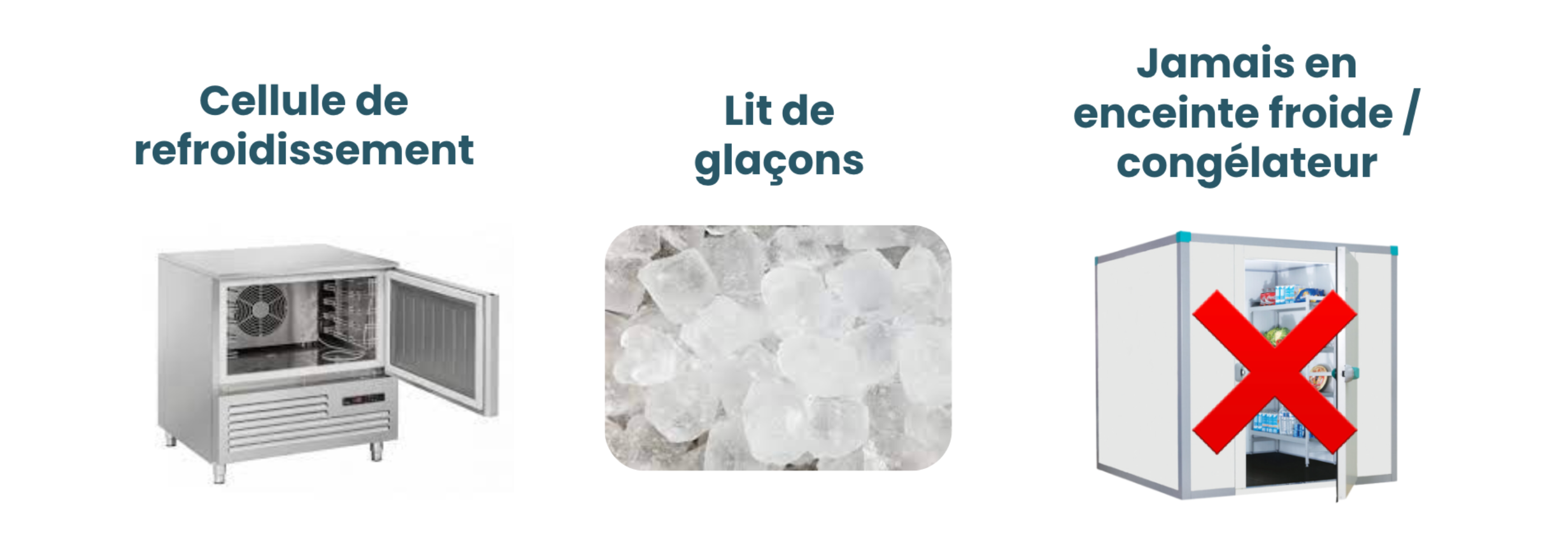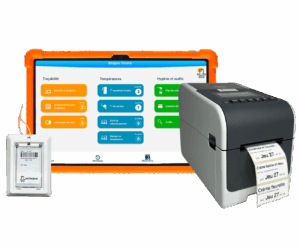HACCP best practices for food service sample dishes
Traçabilité
? Mis à jour le : 12/01/2025
In this article, we offer you a complete guide on best practices for managing sample dishes in your establishment: legal obligations, sampling techniques, storage duration, and labeling. We cover all the essential points to know to comply with regulations and ensure food safety. ✅
What is a control dish? ?
What does the regulation say about sample dishes? ⚖️
However, some foods, such as dishes or products prepared to order, for example: plated service in traditional restaurants, sandwich shops, etc., or individually prepackaged products like biscuits, cheeses, or fresh fruits, do not require sample collection. ❌
This practice is a requirement under HACCP standards, which aim to ensure consumer safety and prevent foodborne illness risks. ✅
What are the legal obligations? 🤔
According to the HACCP method and regulations, establishments whose sanitary control plan includes the collection of sample dishes must comply with several points:
🧪 Sampling: A portion of the dish, about 100g, must be collected before it is served to consumers. Sampling should be done as close as possible to the time of service so that, in case of a TIAC, the analyzed samples accurately represent the dish consumed. In certain cases (vulnerable populations, services lasting more than 2 hours, etc.), it is recommended to take samples at the beginning and end of service.
❄️ Storage conditions: Samples must be stored in clean, airtight packaging, such as a small food-grade plastic bag, at a storage temperature between 0°C and 3°C.
⏳ Storage duration: Sample dishes must be kept for at least 5 days to allow reliable analysis in case of a health incident.
What is the purpose of the legal obligations surrounding sample dishes? 🤔
The legal obligations related to sample dishes play a key role in food safety. These samples allow to:
🛡️ Protect consumers : If a suspicion of TIAC arises, the sample can be analyzed to identify the source of contamination and take immediate measures to limit risks.
✅ Ensure compliance with standards: In case of sanitary control or inspection, proper management of sample dishes, compliant with your sanitary control plan (PMS), demonstrates adherence to regulatory obligations regarding food safety.
Which type of establishment must collect sample dishes?
The obligation to keep sample dishes is linked to the risk identified in the sanitary control plan, related to the mode of production and service, and generally concerns:
- Central kitchens;
- Satellite kitchens (attached to central kitchens);
- Company restaurants;
- School and university cafeterias;
- Daycare centers;
- Hospitals and clinics;
- Public administration restaurants;
- Nursing homes and retirement homes;
- Commercial buffet services: hotels, all-you-can-eat buffets, cafeterias;
- Production laboratories;
- Caterers, etc.
Note ✏️ :
Satellite kitchens that do not handle food (cutting, mincing, etc.?) are not required to collect sample dishes, which are taken by the central kitchen. Thawing and assembly operations also do not require sampling. In these cases, it is the central kitchen’s responsibility to collect samples before dispatching them via cold or hot chain transport. 🧊🔥
In which cases is keeping a sample dish not mandatory? ⚖️
In certain situations, sampling is not mandatory. These exceptions mainly concern cases where health risks are considered low and the foods do not pose a collective danger, notably:
- 🍽️ Made-to-order dishes: These are dishes cooked and served immediately, such as grilled items, salads, etc.
- 📦 Individually prepackaged products: Foods packaged before delivery (biscuits, dairy products, beverages, etc.) already have their own traceability thanks to their labels.
- 🥕 Raw unprocessed foods: This includes fresh fruits, raw vegetables, or other similar products.
Collecting and storing samples: what are the best practices? ✅
What quantity should be kept? ⚖️
The sample of the dish must represent between 80 and 100 grams of each dish served during the meal, including starters, main courses, side dishes, and desserts.
How long should the sample be kept? ⏳
The sample of the dish must be kept for a minimum of 5 days from the date it was taken. This period allows for analyses to be performed in case of a foodborne outbreak (TIAC) or sanitary inspection, while ensuring the sample remains suitable for analysis. 🧪
Under what conditions should the sample be stored?
To ensure the integrity of the sample and keep it in the same state as when it was consumed, the following conditions must be respected:
📦 Packaging: Use a clean, airtight, and durable container; a food-grade plastic bag sealed properly will suffice. The sample must be labeled with clear information, including:
-
- The date or day of the week;
- The service time: morning, noon, evening, in case of multiple services or the exact time the sample was taken;
- The type and/or name of the dish;
- The temperature at the time of sampling;
- The batch number, if applicable;
- The location if the establishment has multiple service lines;
- The name of the person responsible or operator.
🌡️ Temperature: Sample dishes must be stored in a dedicated space at a temperature between 0°C and +3°C. This temperature range limits bacterial growth.
📝 Traceability: Ensure that each sample is properly recorded in a register to locate it quickly in case of inspection or foodborne outbreak (TIAC).
Cooling of Hot Sample Dishes: How to Proceed? ❄️
Cooling hot sample dishes is a key step to ensure optimal storage conditions and limit the risk of bacterial growth.
Use of a Blast Chiller
If you have a blast chiller, we recommend using it. It is the most effective method to quickly lower the temperature.
Using an Ice Bath?
If you don’t have a blast chiller, an ice bath can be an effective alternative. Place the sample in a sealed plastic bag. Put this bag in the ice bath and leave it until the temperature drops below 10°C, within 2 hours.
Once cooled, transfer the sample to your cold room at a temperature below 3°C.
Warning ⚠️
We do not recommend placing your hot sample dishes directly into your cold room for rapid cooling.
This can raise the temperature of other foods stored in your cold room, leading to their deterioration and making them unsafe to consume.
It can also damage your cold room, which will have to consume more energy to compensate for the heat introduced by the hot sample.

Why Label a Sample Dish? 🏷️
Labeling samples ensures their traceability by allowing to:
1. Clearly identify the sample:
- What it is: the name of the dish. 🍽️
- When it was served: the date and time of sampling, and the service (lunch or dinner). ⏳
- Where it was prepared: the name of the establishment. 🏢
2. Ensure traceability of ingredients: If a suspicion of a foodborne illness (TIAC) occurs, the information on the label allows quick identification of the sample and facilitates its analysis. Result: time saved and a simplified sanitary investigation.
3. Comply with regulations: Labeling is a legal obligation under HACCP standards.
4. Facilitate storage and organization 🗂️
5. Be ready for health inspections: In case of inspection, a well-labeled sample shows that your establishment is serious and compliant with standards.
With Octopus HACCP, you can generate labels for your sample dishes in just a few clicks using our Brother printer.
What to do in the event of a TIAC ? ?️
Here are the steps to properly manage a TIAC in your establishment:
1) Alert the competent authorities ⚠️
You must report the TIAC without delay to the following organizations:
- The ARS Medical Inspector (Regional Health Agency), or;
- The Food Quality and Safety Service (Departmental Directorate for Social Cohesion and Consumer Protection – DDCSPP). ✅
The declaration is mandatory and must be made by filling out a form. This procedure can be carried out by:
- A doctor who diagnosed the food poisoning;
- The person in charge of the establishment where the TIAC occurred;
- The head of the family, in a family context.
2) Preserve necessary elements for the investigation ⚠️
To facilitate the investigation and identify the source of contamination, keep:
- 🍽️ The sample dishes served during the suspected service;
- 🏷️ The labels of the ingredients used, to analyze their composition and origin;
- 🏥 Biological samples :
- If symptoms such as diarrhea or vomiting appear in diners, collect stool samples and/or gastric contents from several affected individuals. Use special containers available at pharmacies. If unavailable, a clean hermetic container will suffice.
- Analyses must be prescribed by a doctor and performed in a medical laboratory.
3) Gather all necessary information ⚠️
To assist health authorities in their investigation, prepare a file including:
- The number of diners who consumed each meal served in the 5 days prior to the first symptoms;
- A list of the sick, specifying:
- Their age,
- The symptoms experienced,
- The dates and times symptoms appeared;
- A list of staff members working in the kitchen during the 5 days prior to symptom onset;
- The composition of meals consumed by the sick and, for comparison, a representative sample of unaffected diners.
4) Analyze to prevent future incidents ⚠️
By identifying possible causes of the TIAC, you will be able to direct the measures to implement to prevent recurrence in your establishment. This may include revising your HACCP protocols or providing additional training for staff.




